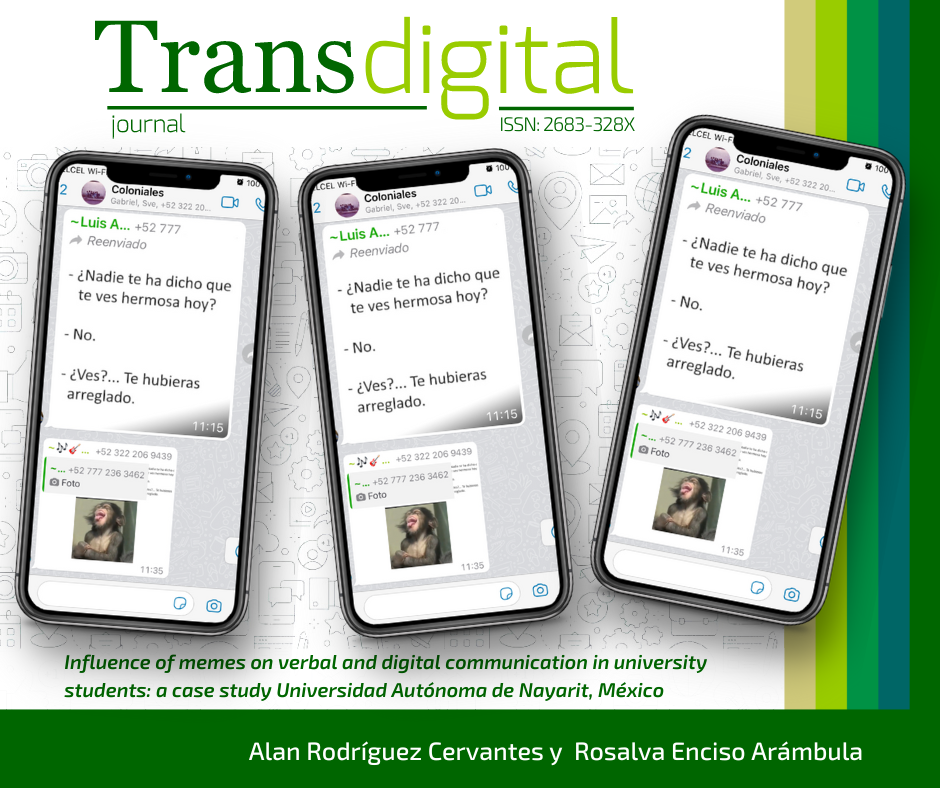Influence of Memes on verbal and digital communication in university students: a case study Autonomous University of Nayarit, Mexico
DOI:
https://doi.org/10.56162/transdigital162Keywords:
meme, verbal communication, digital communication, Facebook, internetAbstract
The aim of the research was to know the influence of memes on verbal and digital communication in Facebook services in the students of the Autonomous University of Nayarit, Mexico, of the Bachelor's Degrees in Communication and Media, Psychology, Philosophy and Applied Linguistics. The research was carried out with a mixed approach. The population considered was 4,086 university students. A determined probabilistic sample of 301 students was considered. The techniques of the survey, interview, observation and focus group were used. The instruments to collect information were the questionnaire, interview scripts and registration formats. The results highlight that 87.9% share memes on Facebook or Whatsapp; 100% use emojis, emoticons or stickers in their daily digital conversations; have used a meme to substitute words, phrases, sentences, or ideas in face-to-face conversations. It is concluded that the meme has influenced and modified the way in which university students communicate. This influence has occurred both on Facebook and in their face-to-face conversations. He realizes that verbal citation is a very common practice. In addition, they had an impact on the identity of the subjects. For the scope of the study of the meme from the communication itself, the memetic theory of communication is proposed.References
Campos, F. (2008). Las redes sociales trastocan los modelos de los medios de comunicación tradicionales. Revista Latina de Comunicación Social, 63, pp. 287-293.
Dawkins, R. (1976). The selfish gene. Oxford University Press.
ENDUTIH. (2014). Encuesta Nacional sobre Disponibilidad y Uso de Tecnologías de la Información en los Hogares (ENDUTIH). https://www.inegi.org.mx/programas/modutih/2014/
ENDUTIH. (2018). Encuesta Nacional sobre Disponibilidad y Uso de Tecnologías de la Información en los Hogares (ENDUTIH). https://www.inegi.org.mx/contenidos/saladeprensa/boletines/2019
Fajardo, L. A. (2009). A Propósito de la Comunicación Verbal. Forma y Función, 22(2),121-142. https://revistas.unal.edu.co/index.php/formayfuncion/article/view/23763/24442
García, A. (2020). Memes de Internet. Aspectos de Género y Autoría. Con atención a los gestados en las elecciones 2018 en México. Capítulo 2, “El meme de internet, género comunicativo” (Tesis doctoral no ha sido publicada). Universidad de Guadalajara.
González, M. (2015). Las redes sociales y su incidencia en la forma en que los jóvenes se comunican y utilizan la lengua. Perspectiva de los docentes de lenguaje y comunicación. [Tesis de postgrado] http://repositorio.uchile.cl/handle/2250/136443
Gutiérrez, G. (2006). Metaforización como vehículo de representación discriminante. Ejemplos de prensa de Guadalajara (principios del siglo XX). Comunicación y Sociedad, (5) pp. 59-87. https://www.comunicacionysociedad.cucsh.udg.mx/index.php/comsoc/article/view/4011
Gurevich, A. (2016). El tiempo todo en Facebook. Aposta. Revista de Ciencias Sociales, 69, pp. 217-238, Universidad de Buenos Aires, Argentina. http://www.apostadigital.com/number.php?id_num=78
Hernández, R., Fernández, C., y Baptista, P. (2017). Metodología de la investigación. Editorial Mc Graw Hill.
Herring, S. (2017). "I'm the first video Voicethread–it's pretty sweet, I'm pumped": Gender and Self-Expression on an Interactive Multimodal Platform, Identity Construction in Social Media, 20(1). https://doi.org/10.4000/alsic.3007
Jasso Medrano, J., López Rosales, F., & Díaz Loving, R. (2018). Conducta adictiva a las redes sociales y su relación con el uso problemático del móvil. Acta de Investigación Psicológica, 7(3), 2833 - 2838. https://doi.org/10.1016/j.aipprr.2017.11.001
Konrad, A., Herring, S, y Choi, D. (2020). Sticker and Emoji Use in Facebook Messenger: Implications for Graphicon Change. Journal of Computer-Mediated Communication, 25, 217-235. 10.1093/jcmc/zmaa003
Noguera, J. M. (2010): "Redes sociales como paradigma periodístico. Medios españoles en Facebook", Revista Latina de Comunicación Social, 65, 177-186.
Raible, W. (2004). ¿Qué es un texto? https://romanistik.uni-freiburg.de/raible/Publikationen/Files/Que_es_un_texto.pdf
Sánchez, J. A. (2010). La comunicación sin cuerpo: Identidad y virtualidad. Revista mexicana de ciencias políticas y sociales, 52(209), pp. 37-52. https://www.revistas.unam.mx/index.php/rmcpys/article/view/25962
Vera, J.A., y Valenzuela, J.E. (2012). El concepto de identidad como recurso para el estudio de transiciones. Psicología & Sociedades, 24(2), 272-282. https://investigadores.unison.mx/es/publications/el-concepto-de-identidad-como-recurso-para-el-estudio-de-transici

Downloads
Autor de correspondencia
El autor de correspodencia se identifica con el siguiente símbolo: *Published
How to Cite
License
Copyright (c) 2023 Alan Rodríguez Cervantes, Rosalva Enciso Arámbula

This work is licensed under a Creative Commons Attribution 4.0 International License.
All articles in Transdigital are licensed under a Creative Commons Attribution 4.0 International License. Authors hold the copyright and retain publishing rights without restrictions.









